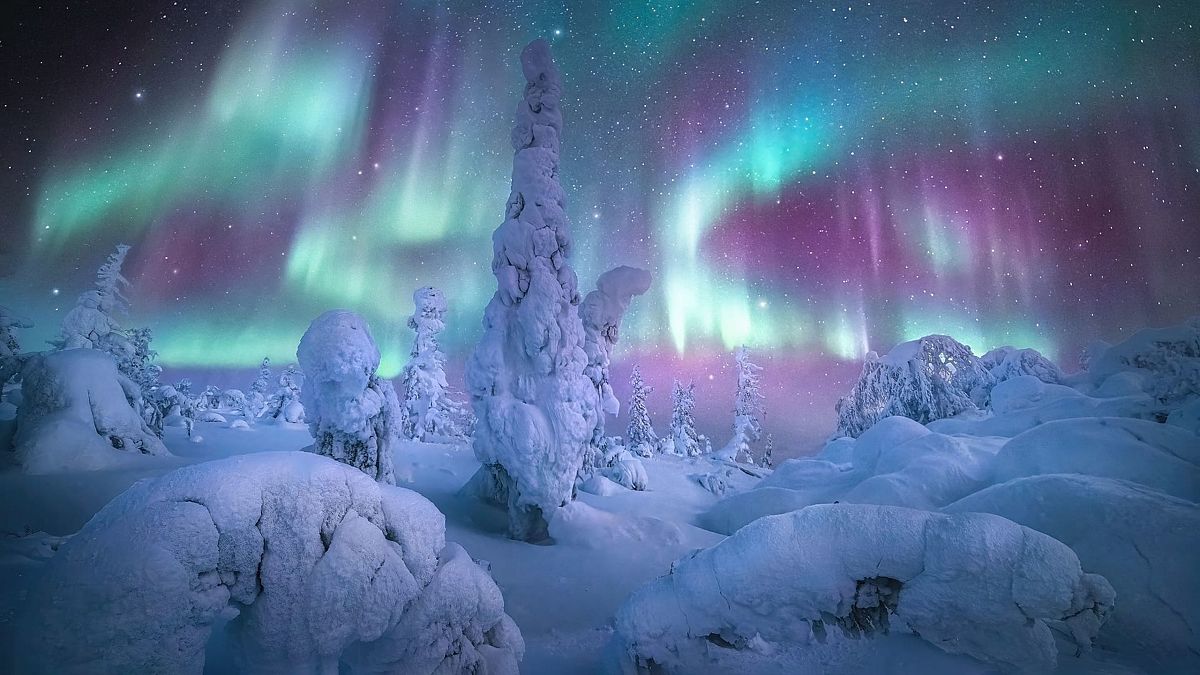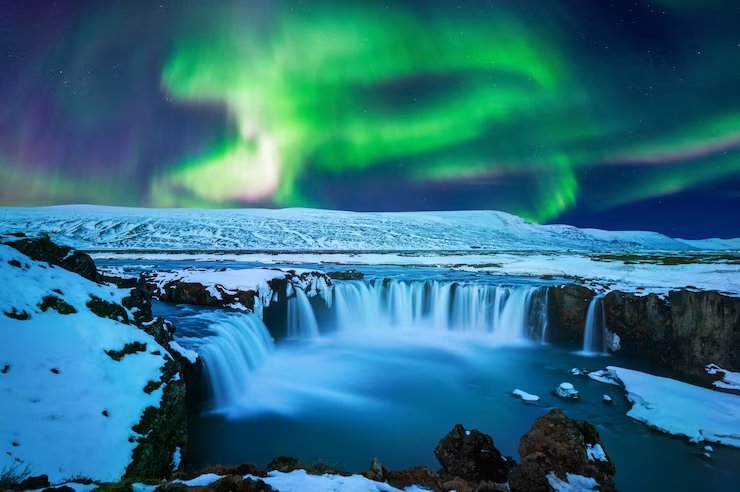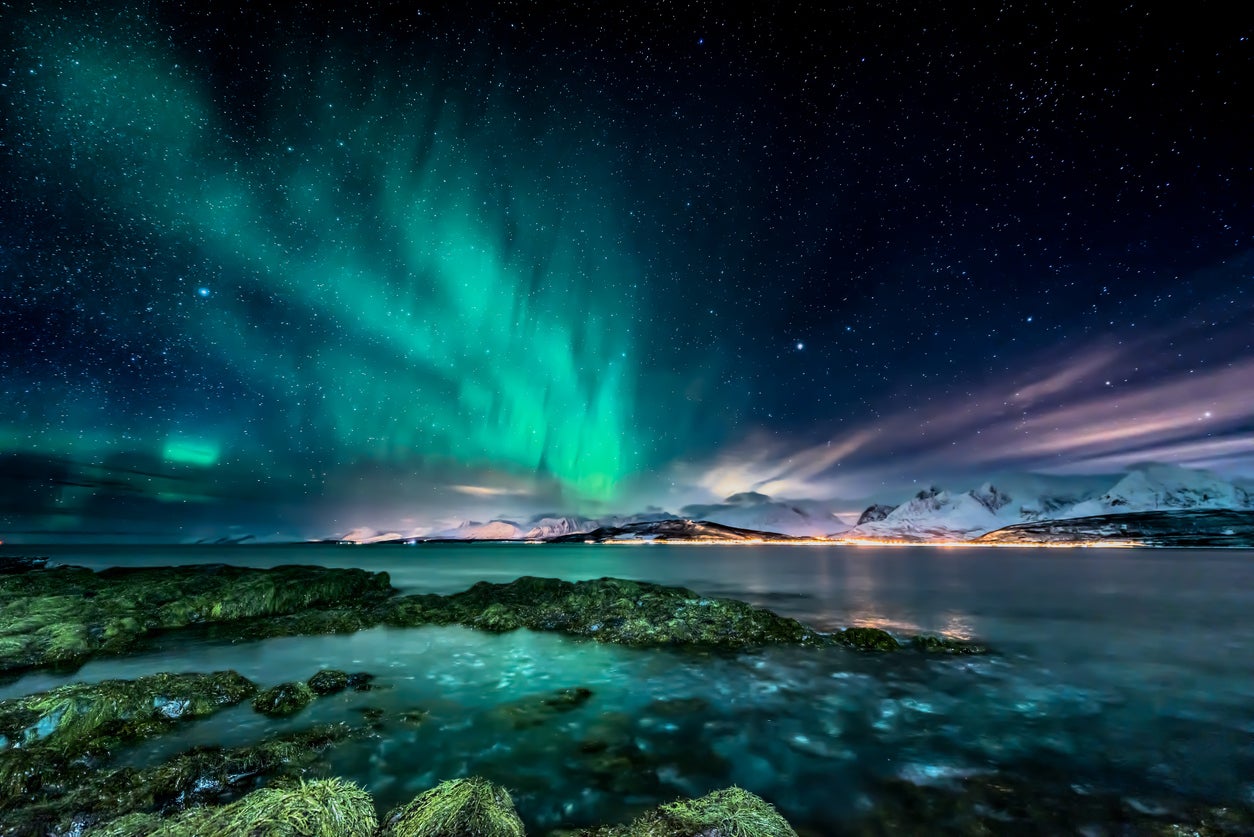The Holy Grail of Skywatching -Northern Lights
The northern lights are an atmospheric phenomenon that's regarded as the Holy Grail of skywatching.
The northern lights, or the aurora borealis, are beautiful dancing ribbons of light that have captivated people for millennia. But for all its beauty, this spectacular light show is a rather violent event.
The northern lights are created when energized particles from the sun slam into Earth's upper atmosphere at speeds of up to 45 million mph (72 million kph), but our planet's magnetic field protects us from the onslaught.
As Earth's magnetic field redirects the particles toward the poles — there are southern lights, too, which you can read about below — the dramatic process transforms into a cinematic atmospheric phenomenon that dazzles and fascinates scientists and skywatchers alike.
HOW DO THE NORTHERN LIGHTS FORM?
At any given moment, the sun is ejecting charged particles from its corona, or upper atmosphere, creating the solar wind. When that wind slams into Earth's ionosphere, or upper atmosphere, the aurora is born. In the Northern Hemisphere, the phenomenon is called the northern lights (aurora borealis), while in the Southern Hemisphere, it's called the southern lights (aurora australis).
"These particles are deflected towards the poles of Earth by our planet's magnetic field and interact with our atmosphere, depositing energy and causing the atmosphere to fluoresce," Billy Teets, the director of Dyer Observatory at Vanderbilt University in Nashville, Tennessee told Space.com.
The bright colors of the northern lights are dictated by the chemical composition of Earth's atmosphere.
"Every type of atom or molecule, whether it's atomic hydrogen or a molecule like carbon dioxide, absorbs and radiates its own unique set of colors, which is analogous to how every human being has a unique set of fingerprints," Teets told Space.com.
"Some of the dominant colors seen in aurorae are red, a hue produced by the nitrogen molecules, and green, which is produced by oxygen molecules." Teet continued.
What causes the movement and shape of auroras?
Constantly changing input from the sun, varying responses from the Earth's upper atmosphere, and the motion of the planet and particles in near-Earth space all conspired to cause different auroral motions and shapes. From these motions and shapes, we can learn about the physics happening further out in space along the Earth's magnetic field lines.
What do auroras tell us about Earth's atmosphere?
Auroras tell us many things about Earth's upper atmosphere, including its density, composition, flow speeds, and the strength of electrical currents flowing in the upper atmosphere. These in turn tell us about the Earth's magnetic field, how it extends into space, and how it changes dynamically. All of this is important for protecting Earth and space-borne technologies from hazards of "space weather" of which aurora is one part.
NORTHERN LIGHTS AND SOLAR MAXIMUM
While solar wind is constant, the sun's emissions go through a roughly 11-year cycle of activity. Sometimes there's a lull, but other times, there are vast storms that bombard Earth with extreme amounts of energy. This is when the northern lights are at their brightest and most frequent.
Lucky for aurora hunters, we are currently approaching solar maximum which is predicted to peak between early 2024 to late 2025. Scientists cannot pinpoint exactly when solar maximum will occur but we do know it's on its way.
"Currently for solar cycle 25, by synthesizing all published predictions, the time interval for the cycle maximum ranges from late 2023 to early 2025" Frédéric Clette, solar physicist, World Data Center Sunspot Index and Long-term Solar Observations (SILSO) and Solar Influence Data analysis Center (SIDC) told Space.com in an email.
NOAA's Space Weather Prediction Center (SWPC) recently issued a revised prediction that suggests solar maximum may occur between January and October 2024.
If you're planning an aurora hunting trip now is the time as "the next 4-5 years will be the most favorable for auroral sightings," Clette continued.
WHERE AND WHEN TO SEE THE NORTHERN LIGHTS
Seeing the northern lights with your own eyes is a bucket-list item for astronomy lovers and travelers alike. Fortunately, they occur frequently.
"The northern lights are happening 24 hours a day, seven days a week, 365 days a year," said photographer Chad Blakely, owner of the northern lights tour company Lights Over Lapland. But that doesn't mean they're easy to spot; you need to be at the right place at the right time.
The best place to see the northern lights is any destination in the "auroral zone," the area within an approximately 1,550-mile (2,500 kilometers) radius of the North Pole, according to the Tromso Geophysical Observatory in Norway. That's where the aurora most frequently occurs, though the phenomenon can creep farther south during particularly strong solar storms.
If planning a trip to see the northern lights, we recommend Hurtigruten's Astronomy Voyage which combines northern lights viewing, astronomy lectures and the beautiful Norwegian coastline. You can read all about what it's like onboard in our article "What it's like to chase the northern lights along Norway's dramatic coastline".
Within the auroral zone, it's best to be as far away from city lights as possible to maximize visibility. But it's pretty tricky to get into the middle of the Arctic wilderness, even with a guide, so it's best to base yourself in a destination with solid infrastructure, like Fairbanks, Alaska; Yellowknife, Canada; Tromsø, Norway; Abisko National Park, in Sweden; Rovaniemi, Finland; and pretty much anywhere in Iceland.
The best time of year to see the northern lights is between September and April, when the sky gets dark enough to see the aurora. (Far northern locales experience the midnight sun, or 24 hours of daylight in the summer.) The most action usually happens between 9 p.m. and 3 a.m., according to the Geophysical Institute of the University of Alaska Fairbanks.
You can also monitor aurora forecasts from the University of Alaska Fairbanks' Geophysical Institute and NOAA, which offers both three-day and 30-minute forecasts.
NORTHERN LIGHTS VS THE SOUTHERN LIGHTS (AND STEVE)
On Earth, the northern lights' counterpart in the Southern Hemisphere is the southern lights they are physically the same and differ only in their location. As such, scientists expect them to occur simultaneously during a solar storm, but sometimes the onset of one lags behind the other.
"One of the more challenging aspects of nightside aurorae involves the comparison of the aurora borealis with the aurora australis," said Steven Petrinec, a physicist at the aerospace company Lockheed Martin who specializes in magnetospheric and heliospheric physics told Space.com.
"While some auroral emissions occur in both hemispheres at the same magnetic local time, other emissions appear in opposing sectors in the two hemispheres at different times — for example, pre-midnight in the Northern Hemisphere and post-midnight in the Southern Hemisphere," Petrinec told Space.com.
The hemispheric asymmetry of the aurora is due in part to the sun's magnetic field interfering with Earth's magnetic field, but research into the phenomenon is ongoing.
Another aurora-like occurrence on Earth is STEVE ("Strong Thermal Emission Velocity Enhancement"). Like the northern and southern lights, STEVE is a glowing atmospheric phenomenon, but it looks slightly different from its undulating auroral counterparts. "These emissions appear as a narrow and distinct arc, are typically purple in color and often include a green picket-fence structure that slowly moves westward," Petrinec said.
STEVE is also visible from lower latitudes, closer to the equator, than the auroras.
A 2019 study published in the journal Geophysical Research Letters discovered that STEVE is the result of two mechanisms: The mauve streaks are caused by the heating of charged particles in the upper atmosphere, while the picket-fence structure results from electrons falling into the atmosphere. The latter process is the same driver of the aurora, making STEVE a special kind of aurora hybrid.
THE HISTORY OF THE NORTHERN LIGHTS
Though it was Italian astronomer Galileo Galilei who coined the name "aurora borealis" in 1619 — after the Roman goddess of dawn, Aurora, and the Greek god of the north wind, Boreas — the earliest suspected record of the northern lights is in a 30,000-year-old cave painting in France.
Since that time, civilizations around the world have marveled at the celestial phenomenon, ascribing all sorts of origin myths to the dancing lights. One North American Inuit legend suggests that the northern lights are spirits playing ball with a walrus head, while the Vikings thought the phenomenon was light reflecting off the armor of the Valkyrie, the supernatural maidens who brought warriors into the afterlife.
Early astronomers also mentioned the northern lights in their records. A royal astronomer under Babylon's King Nebuchadnezzar II inscribed his report of the phenomenon on a tablet dated to 567 B.C., for example, while a Chinese report from 193 B.C. also notes the aurora, according to NASA.
The science behind the northern lights wasn't theorized until the turn of the 20th century. Norwegian scientist Kristian Birkeland proposed that electrons emitted from sunspots produced the atmospheric lights after being guided toward the poles by Earth's magnetic field. The theory would eventually prove correct, but not until long after Birkeland's 1917 death.
Thank you for reading this far. You can follow me to see my other content.





































